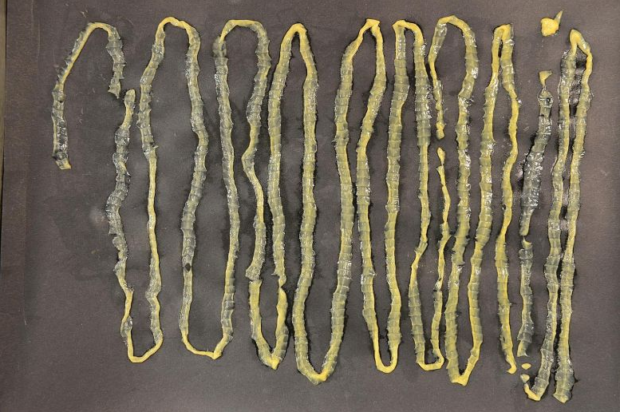
PHOTO from SINGAPORE GENERAL HOSPITAL’S DEPARTMENT OF MICROBIOLOGY via The Straits Times/Asia News Network
The tapeworm that grew in the gut of a patient here was so long that it was at least one and a half times his height. When fully stretched out, it measured all of 2.8m.
In order for it to be captured in an image taken by the Singapore General Hospital’s (SGH) Department of Microbiology, the worm had to be folded 18 times to fit into the picture.
Despite its length, the patient showed no signs at all that a parasite was growing in his body.
“The patient was somewhat appalled when the worm was passed out via the rectum,” said infectious diseases expert Hsu Li Yang.
He shared this 2016 case with The Sunday Times when asked for local examples of people being infected with parasites like worms after eating uncooked or undercooked seafood.
The Washington Post reported earlier this month that a 30-year-old man who ate raw fish almost every day found a 1.6m-long tapeworm hanging from his rear end. He had stomach cramps and bloody diarrhea after eating salmon sashimi. The tapeworm, which kept on coming out from his anus, was pulled out of his body alive and moving.
Professor Hsu said the 2.8m-long worm seen in Singapore was clearly a tapeworm as no other human parasite can grow to such a length.
“The question is what tapeworm, which will also help answer how the patient had acquired the worm.”
An adult tapeworm has a head, neck and chain of segments called proglottids. During an intestinal infection, the tapeworm head sticks to the intestinal wall, and the proglottids grow and produce eggs.
People get tapeworms mostly by eating undercooked pork, beef or fish. From the egg obtained from a segment of the 2.8m-long tapeworm excreted out, the SGH’s Department of Microbiology said the egg most closely resembled those of fish tapeworms.
Most fish tapeworms are acquired by the consumption of raw or undercooked freshwater fish, as well as fish that spend a considerable amount of their life in fresh water, such as salmon.
Prof Hsu suspects infestation with fish tapeworms has increased over the years in Singapore, similar to the situation in other developed countries where raw fish consumption has been on the rise. But he said this cannot be confirmed as no data is recorded and people who are infected may not have any symptoms.
According to the Agri-Food and Veterinary Authority (AVA), 84,027 tonnes of fish were consumed in 2016.
However, parasitic infections – which are treated with medications – happen rarely. While many people with tapeworm infection do not have symptoms, others may experience nausea, weakness, diarrhoea and abdominal pain.
Prof Hsu is aware of only two fish tapeworm cases last year.
Other common parasites found in seafood include roundworms and flukes, a kind of flatworm.
Over at the National University Hospital (NUH), the longest worm seen so far was a 1m-long pork tapeworm five years ago.
NUH sees about two to three worm cases a year, said Dr Jolene Oon, a consultant at its division of infectious diseases. However, these cases may include other worms like hookworms that are acquired from poor sanitation practices overseas and not from eating raw food.
While parasitic infections are rare, there have been cases of bacterial infections from consuming raw or undercooked seafood.
One well-known example is the Group B Streptococcus (GBS) infection from consuming raw fish. There was a major GBS outbreak in Singapore in 2015.
Another example is scombroid poisoning, which is due to the improper storage and handling of fish, resulting in spoilage. When the fish decays and is broken down by bacteria, a toxin is produced.
Dr Goh E. Shaun, a consultant at Raffles Hospital, gave an example of such a case a few months ago, involving a couple who ate pan-seared tuna from a local Italian chain restaurant.
He said: “They had rashes, abdominal discomfort, vomiting and diarrhoea. Both were treated in the emergency department and recovered in a few hours.”
Doctors said it is very hard to tell with the naked eye if a piece of raw fish is contaminated.
Only experienced sushi chefs and fish suppliers can detect parasite cysts in the flesh of the fish, said Prof Hsu.
Even as Chinese New Year rolls around and lohei season starts, doctors said there is no cause for worry.
Said Dr Leong Hoe Nam, an infectious diseases physician at Mount Elizabeth Novena Hospital: “The risk of catching something from eating raw food is extremely low in Singapore. But be extremely… religious about cleanliness and don’t eat raw fish if your immunity is poor.”
If consumers buy pre-packed yusheng, AVA said they should check that the food packaging is intact and food items are not bruised or mouldy, keep it chilled until it is ready to be served and eat it within two hours of mixing.